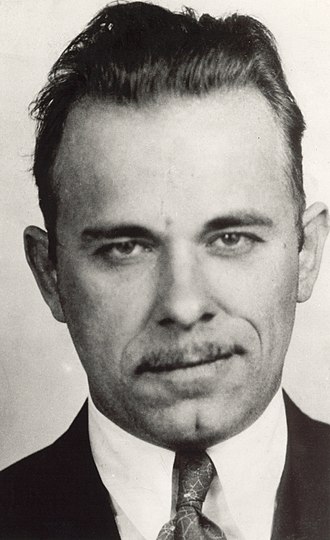By Marc Kelley As with many of the Gangsters of the 1930’s, John Dillinger was and continues today, to be portrayed as a modern day “Robin Hood” fighting for the little guy against the big money banks and corrupt politicians of the time. Books have been written, movies have been made, and stories have been told of how this charismatic Gangster lived and how he died. Dillinger loved the limelight as much as any politician alive today and he often posed for photographs working his charm and becoming a master at manipulating the media. Much like those who seek the bright lights of fame, Dillinger was constantly baiting the media into telling his story, the way he wanted it to be told. A deeper look into the life of John Dillinger reveals a man who was very much a creature of habit and a man who spared no expense to indulge his depravity. Dillinger loved women and there is little doubt he was attracted to a certain “type”. Beautiful women with dark hair, dark eyes, and a misguided sense of loyalty, would always be on his arm or at his side. Whether or not you believe he loved these women is for you to decide. What is not in question is the fact, John Dillinger drew his final breath on July 22, 1934 while enjoying the spoils gained from a life of crime. |
| John Herbert Dillinger was born in Indianapolis, Indiana on June 22, 1903. He was the youngest of three children born to a second generation of immigrant parents, whose family came to our country in the early 1850’s. In an interview given by Dillinger himself, he described his childhood as “harsh”, going so far as to explain his Father believed in the concept, “spare the rod and spoil the child”. Whether this was in fact the truth or simply part of the story John Dillinger wanted the public to believe, it seems clear his Father was unable to convey his message to his son. Dillinger’s Mother died just before his fourth birthday and he was raised by his sister for several years, until his Father remarried in 1912. Most accounts of this time tell of a difficult relationship between Dillinger and his Stepmother. Dillinger’s teen years were especially tough for himself as well as his family. The young Dillinger was constantly in trouble for petty theft and bullying younger, smaller children. Unable to get along with the other students, Dillinger left school and began working in a machine shop; however, his criminal behavior continued. Constantly in trouble and running with the wrong crowd, Dillinger’s Father intervened and moved his family to the rural town of Mooresville, Indiana. Once again, a change of venue would not change the young man’s behavior and within a year after the move, he was arrested for auto theft. Given the choice between going to prison and enlisting in the military, Dillinger chose the latter, and entered the Navy, where he served as a Fireman, 3rd Class aboard the USS Utah. Dillinger fared no better with the discipline that comes with serving in the military and within a few months he deserted and was ultimately dishonorably discharged. |
| June 21, 1933 Dillinger robbed the New Carlisle National Bank in New Carlisle, Ohio and made off with $ 10,000.00. Twenty three days later he robbed a bank in Bluffton, Ohio and was captured by police who had been following his movements. Upon his arrest and search, a document was discovered which appeared to lay out a plan for a prison escape. Dillinger refused to answer any question about the document and the police never realized what they had in their possession. The document in question was in fact Dillinger’s personal notes covering a plan to break his friends out of prison. The plan called for firearms to be smuggled into the laundry facility of the Indiana State Prison where his friends held prison jobs. Four days after Dillinger’s capture, Pete Pierpoint, Russell Clark, Charles Makley, Ed Shouse, Harry Copeland and John Hamilton, escaped from the Indiana State Prison, following Dillinger’s plan. Returning the favor, on October 12, 1933, Pierpoint, Clark and Makley posed as Indiana State Police Officers, and claimed to be part of the extradition order to return Dillinger to Indiana to face charges in that state. When asked for their credentials, Pierpoint pulled his firearm and shot Sheriff Jess Sarber in the head at point blank range. The four men escaped to Indiana and formed what would be called the “Terror Gang”, with John Dillinger leading the crew and planning their robberies. Over the next twelve months The Terror Gang would commit a string of twelve bank robberies. It is also during this time period, John Dillinger would meet his second dark haired, dark eyed stunningly beautiful, female companion…her name was Billie Frechette. |
| Dillinger had always enjoyed the “party life” and the un-ending supply of young women on whom he would ply with his charm and flattery. The subject of the many women Dillinger was involved with, caused friction between the other members of the gang, but none more so, then with Helen Gillis, the wife of “Baby Face” Nelson. Yet no amount of warning or council would get through to John Dillinger. In what would turn out to be a very accurate description, Lester “Baby Face” Nelson warned Dillinger about his penchant for pretty women. After narrowly escaping the shoot-out at The Little Bohemia Lodge, “Baby Face” Nelson told Dillinger, ” mark my words, it will be a woman that will be your death”. Unfazed by the warning, Dillinger is said to have laughed and told his friend he was going to the cabaret to find a “friend” who would appreciate his company. |
“Stranger, stop and wish me well, just a prayer for my soul in Hell. I was a good fellow, most people said,betrayed by a woman all dressed in red. |



